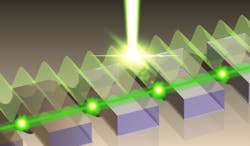Phase-locking technique allows terahertz laser to achieve 2.03 W power output
Promising applications of terahertz lasers have researchers seeking ways to enhance power output and beam quality by improving intensity and brightness. If successful, the ability of terahertz lasers to penetrate common packaging materials, identify and detect various chemicals and biomolecular species, and image certain biological tissues safely may one day be applied in terahertz spectroscopy and sensing systems. One research team with members from Lehigh University (Bethlehem, PA) and Sandia National Laboratories (Albuquerque, NM) has developed a novel phase-locking technique that achieves record-high terahertz laser output power and highest-reported radiative efficiency for any single-wavelength semiconductor quantum-cascade laser (QCL).
Scientists often rely on phase-locking, an electromagnetic control system that forces an array of optical cavities to emit radiation in lockstep, to enhance the optical power output and beam quality of semiconductor lasers. However, terahertz QCLs suffer from low output power and divergent beams due to the use of subwavelength metal claddings to confine light in their optical cavities. While previously reported phase-locking schemes for semiconductor lasers relied on lateral coupling of cavities, the new method implements a longitudinal coupling mechanism by way of single-sided surface plasmon polariton (SPP) waves that are established on top of the metal claddings of the cavities and propagate in the surrounding medium as surface waves.
The primary innovation in this work is in the design of the optical cavities, which has two unique aspects. First, the longitudinal phase locking of a multicavity array differs from other phase-locking schemes for semiconductor lasers that predominantly rely on lateral coupling of multiple cavities. Second, it generates coherent single-sided SPPs propagating as surface waves in the surrounding medium of metal cavities with a large vertical spatial extent, which could lead to the development of new modalities for spectroscopic sensing and wavelength tunability due to access to a coherent SPP wave on top of the plasmonic laser’s cavity. Reference: Y. Jin et al., Optica, 7, 708–715 (2020).

John Lewis | Editor in Chief (2018-2021)
John Lewis served as Editor in Chief of Laser Focus World from August 2018 through October 2021, after having served as the Editor in Chief of Vision Systems Design from 2016 to 2018. He has technical, industry, and journalistic qualifications, with more than 13 years of progressive content development experience working at Cognex Corporation. Prior to Cognex where his articles on machine vision were published in dozens of trade journals, he was a technical editor for Design News, covering automation, machine vision, and other engineering topics, for over six years.
